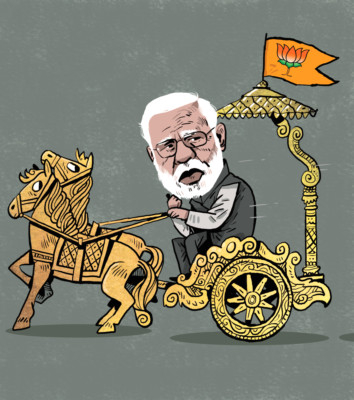Four years ago on May 16, 2014, the India of Gandhi and Nehru was waking up to a new era; an ideology abhorred by the two founding leaders and blamed for the assassination of the former, had swept the nation. The political landscape then appeared to have been painted in saffron — a colour now associated with chauvinistic Hindutva and aggressive nationalism.
Voted in by the urban middle class and endorsed by rich industrialists, Narendra Modi emerged as the undisputed leader of the new India, a nation that cherished its diversity and practised a complex mix of socialism and capitalism contrasted by a healthy dose of left activism.
His party had won absolute majority in Parliament, a first by the right-wing Bharatiya Janata Party (BJP) and also a first by any party in three decades. “India has won. Victory for India. Good days are coming,” Modi tweeted as the country’s bourse gave its thumbs up, opening 800 points up.
Subdued speech
Exactly four years later on Tuesday, a day which began with euphoria over an expected victory, the prime minister made a sombre appearance at his party headquarters in New Delhi. The ‘victory’ word was missing in his speech and the language was conciliatory: “All those who are democratic minded, including friends in civil society, they must come together to strengthen [the] democratic spirit. We cannot see things only in partisan terms.”
The subdued speech was understandable as it became clear that the BJP is falling short of a majority in Karnataka, a state seen as the gateway to the south where the BJP has little presence.
Worse, his rival Congress moved swiftly to stitch together a post-election alliance and staked claim to form the government after voters delivered an inconclusive verdict.
So, is the Modi juggernaut slowing down? To answer this, we have to first understand what was at stake for Modi in Karnataka where the BJP relied on his charisma and oratory skills.
He addressed almost two dozen rallies, unusual for a prime minister to devote days to electioneering in a state election, but then, Modi is a different politician. A Supreme Court judge expressing concerns that important issues of governance require his attention would hardly matter to Modi who is constantly in election mode.
Since May 2014, Modi has bulldozed through opposition strongholds, capturing 21 states in a winning spree that at one point appeared unstoppable. And in every election, Modi is in the front-line, leading his party’s cadre, back-room boys who shape public opinion on social media and a sympathetic media that amplifies his message.
Two, in the bitterly-fought election of Karnataka, Modi raked up controversial issues and his speeches were littered with factual inaccuracies and outright untruths, a clear sign of desperation.
In the middle of the campaign, it was clear that the BJP was fighting a formidable rival in Congress, the state’s ruling party with a decent performance record.
To counter Congress, Modi deployed an old trick — construct a false narrative by invoking historical figures of the state to ridicule Nehru and by extension the present leadership of Congress. Modi’s lies and half-truths were called out by social media users. In the past, this strategy worked perfectly well, bringing him a windfall in almost every election he fought after becoming the prime minister.
Demonising historical Muslim figures
Third, in another sign of desperation in Karnataka, Modi unabashedly endorsed narratives that demonise historical Muslim figures in an attempt to polarise voters on religious lines. In a speech, the prime minister attacked Congress for honouring Tipu Sultan, an 18th century Muslim ruler who fought British colonialists in Karnataka.
In short, Modi deployed every trick in the trade to win Karnataka and yet his party fell short of a majority. Regardless of who manages to form the government, the verdict appears to indicate diminishing returns of ‘Brand Modi’. His rival Rahul Gandhi’s Congress managed to fight anti-incumbency and increased his party’s vote share, a rarity in Karnataka where incumbents are always thrown out of office. Tuesday’s results follow a trend — the BJP facing setbacks in recent by-elections and in his home state Gujarat where the BJP tally went down significantly in December last year.
Rajasthan, Madhya Pradesh and Chhattisgarh — three states where his party is in power — will go to polls, key battles that will keep Modi very busy in the last leg of his five-year-term. The BJP will have to face two major challenges: an anti-incumbency sentiment directed at the three state governments and also that voters will judge Modi’s own record.
On May 14, 2014, he promised good governance and “good days” to the people of India. Those promises are yet to be delivered — the fight against corruption is largely symbolic, job creation has slowed down and it seems the much-talked about 7 per cent economic growth is benefiting only a few in the stock market and some industrialists.
My fear is that the coming election battles will make both the BJP and Modi more desperate and increase dependence upon shrill rhetoric loaded with divisive and controversial issues.











